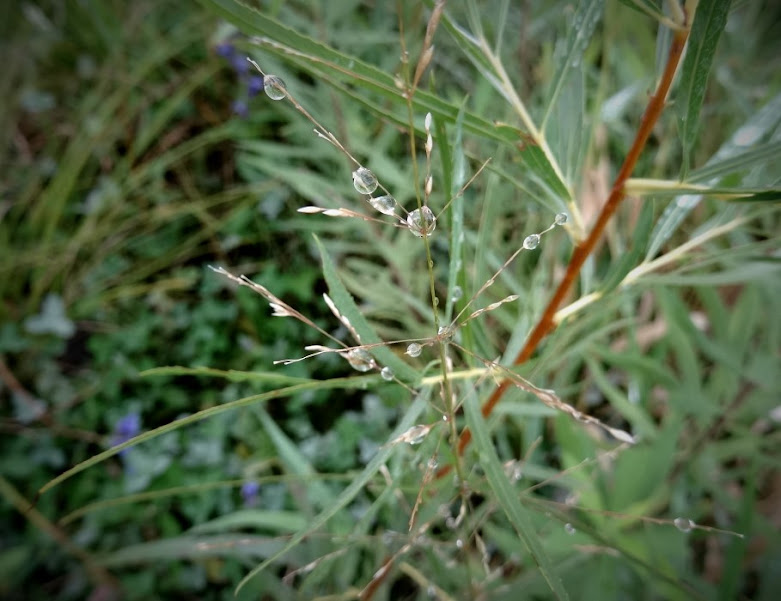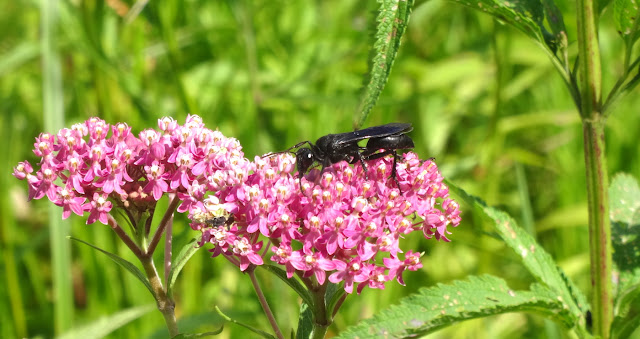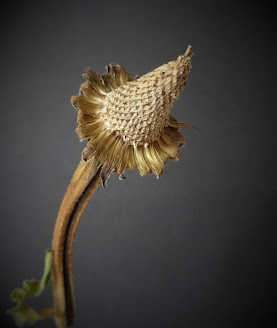
9/17/2020
lobelia still vibrant

9/15/2020
9/12/2020
9/10/2020
ducks in September
Mallards, dabbling ducks who rely on ponds like this one, have been growing and feeding in nearby crop fields while they molted into new feathers. Now we see them on the pond more often than in mid-summer. It is our signal to watch for daily duck visits as they prepare for migration.
9/09/2020
grasshopper on coneflower
On the blooming coneflowers, a Two-striped Grasshopper Melanoplus bivittatus rests in the sunshine. This grasshopper usually lives in sunny, moist, lush, weedy or meadow areas -- like the wetland around the pond. They eat a wide variety of plants, and sometimes also dead animal matter on the ground. They require unsaturated fatty acids in their diet since these nutrients help keep their wings strong and rigid.
9/08/2020
green heron scouting for prey
We have not seen the Green Heron Butorides virescens around the pond since mid-July. This one was balanced today on rocks near the shoreline, its thin legs crossed as it turned its body to spy prey below the water. After a while, it went into the grasses to hunt for another food item.
9/05/2020
Birds seek quiet hidden places while they molt into new feathers each year after nesting season. Here in Minnesota, most birds have passed that phase. So, again we are seeing dabbling ducks and diving ducks visit the pond. Early this morning, three Mergansers were floating on calm water warming themselves in the sunlight. After a while they began diving to find food. They eat fish, mollusks, aquatic insects, and plants. This one was poised to dive, with her wings up, feet back, and bill ready to lead her into the water.
9/03/2020
garden spider
9/02/2020
9/01/2020
monarch on vervain
The Blue Vervain blossoms have mostly gone to seed. In the buffer around the pond, they've been blooming since mid-July. The flowers of Verbena hastata open one by one from the bottom of spikes held on the crown of the plant. This Monarch butterfly looked for nectar in the few remaining flowers at the top of the spike. Along with butterflies, bees and other insects visit Vervain. Now, the seeds will be food for birds like Cardinals, Sparrows, and Juncos.
8/30/2020
planthopper
Planthoppers are masters of disguise. A green Acanalonid Planthopper, hiding on a stem, can look like part of the plant -- a seed pod, leaf, bract, or stipule.
This one is only 3/8 inch long. It was perched on a stem at the leaf sheath, probably sucking sap from the grass. Planthoppers, true to their name, can leap many times the length of their bodies. And they are very agile insects that can move easily forwards, backwards, or sideways.
8/29/2020
sneezeweed
Growing from 2 to 6 feet high on angular winged stems, Sneezeweed Helenium autumnale is blooming on all sides of the pond.
The flowers are showy, golden yellow with a domed center. These late-summer plants will feed butterflies and unfold their blooms until winter comes.
The common name 'Sneezeweed' came about because the pollen, when inhaled, causes sneezing. In the past, the powdered flower heads were used in medicine to cause violent sneezing as treatment.
8/28/2020
green frogs on rocks

8/25/2020
goldenrod
To complement all the blue and purple flowers around the pond this week, the Goldenrod has unfurled its blooms. Solidago species, commonly called Goldenrods, are in a genus of more than 100 species of flowering plants in the aster family, Asteraceae.
Goldenrods are often blamed for allergies, but they have sticky pollen and rely on insects to move most of it. The wind borne pollen of ragweeds and pigweeds are to blame for 'hay fever' in late summer.
These plants are habitat for a large number of insect species. Blooming in late summer, they are a critical nectar source for many bees, butterflies, and moths to fortify themselves before freezing weather comes.
8/24/2020
balanced turtle
This turtle was probably thinking it could be the top part of a balanced rock sculpture. Or, maybe seeking a sunny rock and believed this would be it. Not enough rocks for a sculpture, nor the right shape to be comfortable!
8/22/2020
turtle munching
The pond was quiet and clear today, after a rain shower overnight. We could see to the mud, sand, and rocks on the bottom.
A Painted Turtle Chrysemys picta was very visible in the water, looking for lunch. Painted turtles feed mainly on aquatic vegetation, algae, small water insects, dragonfly larvae, crustaceans, plants like water lily or duckweed, and sometimes dead or injured fish.
When this turtle bumped into a floating mass of algae or plant matter, it was lunch time!
8/21/2020
ironweed
 The tall, stately plants topped by brilliant purple flowers -- blooming now by the pond -- are Common Ironweed Vernonia fasciculata. Each 5- or 6-foot tall plant has a purple-green stem, dark green toothed leaves along the stem, and clusters of flowers at the top. Clusters are made up of many flower heads, each about 3/4” across. After the flowers open and mature, each becomes a fruit that is composed of a dry seed with a tuft of coppery brown hair.
The tall, stately plants topped by brilliant purple flowers -- blooming now by the pond -- are Common Ironweed Vernonia fasciculata. Each 5- or 6-foot tall plant has a purple-green stem, dark green toothed leaves along the stem, and clusters of flowers at the top. Clusters are made up of many flower heads, each about 3/4” across. After the flowers open and mature, each becomes a fruit that is composed of a dry seed with a tuft of coppery brown hair.
This is a host plant for the 'American Painted Lady' butterfly and also has value to native bees.
Ironweed got its common name because of several qualities: tough straight stems like iron rods, fading purple flowers become rusty-tinged, and seeds are colored like rust.
Ironweed is one of about 500 species of perennial plants constituting the genus Vernonia of the family Asteraceae; it's species are distributed throughout the world.
8/19/2020
black wasp
I was surprised and apprehensive to see this big black wasp on a milkweed flower near the pond. It was alarming because of its size (over one inch) but is not a pest to harm people. This Great Black Wasp Sphex pennsylvanicus, looks iridescent violet-black with smoky transparent wings that have a violet sheen. They visit flowers to feed on nectar and pollen; no harm to the plants.
The female Black Wasp digs a burrow in the ground to reproduce her kind. She hunts katydids, paralyzes them, and places several in the burrow. She then lays eggs in the burrow. They hatch into larvae. They have a ready meal, quietly growing into adult Black Wasps.
8/18/2020
blue lobelia
A mid-height plant with tall columns of flowers, Great Blue Lobelia Lobelia siphilitica stands out from the green grasses and foliage in several places around the pond.
This Lobelia started blooming in late July. Its native wildflowers will continue showing clear blue blooms through the autumn as the individual flowers open starting at the bottom of each column.
It attracts butterflies, and provides a color contrast to the gold and yellows of other late summer blooms.
8/17/2020
Coneflower seed harvest
It is time to harvest some wildflower seeds, in order to expand the native plant population in the riparian buffer surrounding our pond. There are more than 30 documented native species in this buffer. Close to the water is a ring of wetland; outside of that is a ring of moist to dry areas. So the pond provides a comfortable home for a wide variety of plants. We hope to reduce the 'weeds' and encourage the flowering native plants to flourish.
For example, a few coneflowers bloom here. Purple Coneflower Echinacea purpurea now has some blooms 'going to seed' as the petals dry out. When I remove the seeds, intending to spread them around the pond for new plants, we can see why this plant is called 'cone flower'.
8/13/2020
song sparrow on branch
Song Sparrows usually stay low to the ground and forage secretively among grasses and wildflower plants. Moving along wetland edges Song Sparrow Melospiza melodia will search for beetles, caterpillars, dragonflies, grasshoppers, snails, or earthworms -- flitting or hopping through plants surrounding the pond to find a meal. They will also eat berries and seeds when insects are not plentiful.
Occasionally males will come to an exposed perch to sing their sweet melody. Song Sparrow sounds
8/12/2020
sandpiper
A hot sultry day in August. The pond was quiet. Several rocks appeared offshore in the last few days, exposed by the lack of rain and lower water level. Good for sandpipers hunting lunch. This Solitary Sandpiper Tringa solitaria shows off its white eye ring while it waits on a rock to spot a meal in or on the water -- aquatic invertebrates such as larvae, worms, flies, or mollusks.
8/11/2020
ladybug on Mountain Mint
8/10/2020
Monkey Flower
Blooming now -- small lilac-purple flowers at the very edge of the pond. Some native plants around the pond, like these, are not noticeable until you get close. Monkey Flower Mimulus ringens. The name comes from the Latin diminutive of mimus meaning "a mimic" or little monkey. The flowers are like tiny snapdragons, less than one inch long. Bumblebees are important native pollinators for this species. Monkey Flower is a native plant, naturalized along the pond's margin.
8/06/2020
Monarch butterfly caterpillars

 |


























